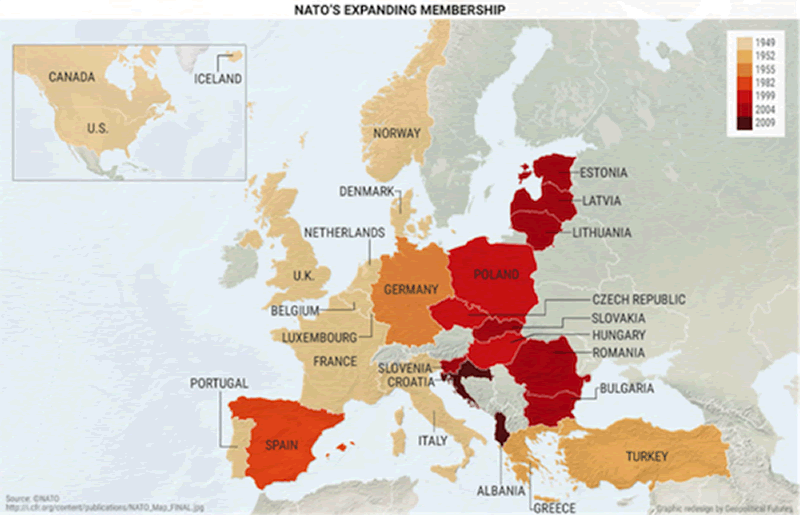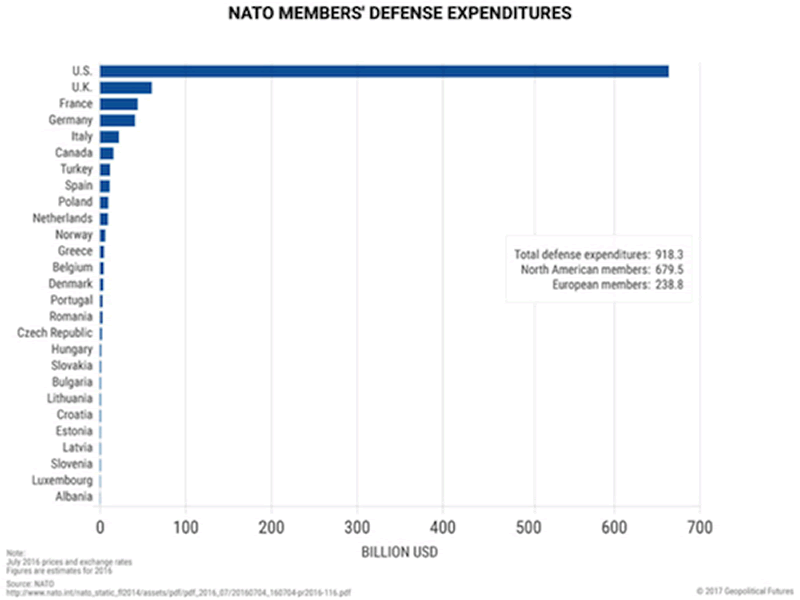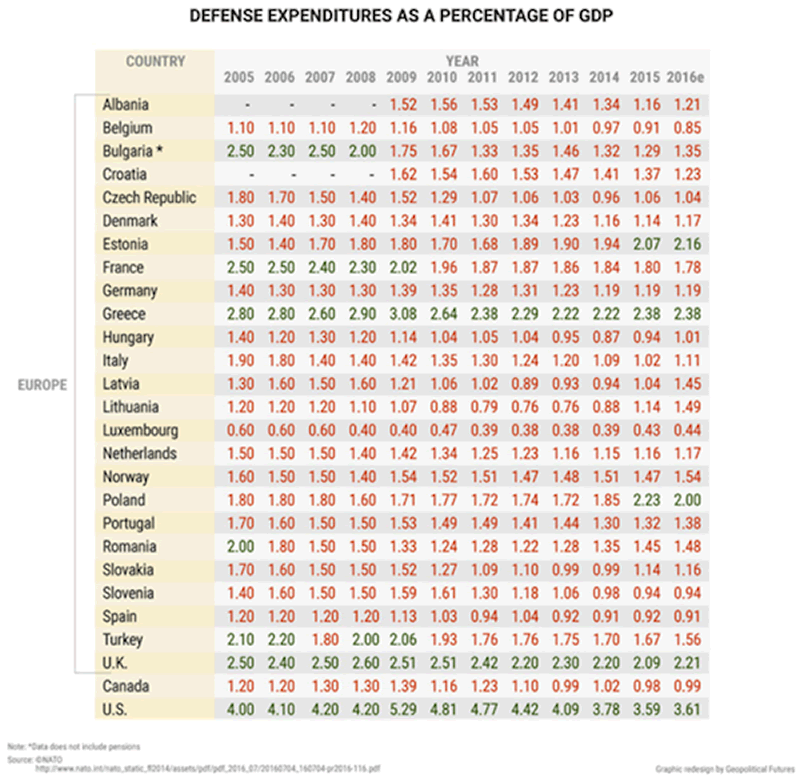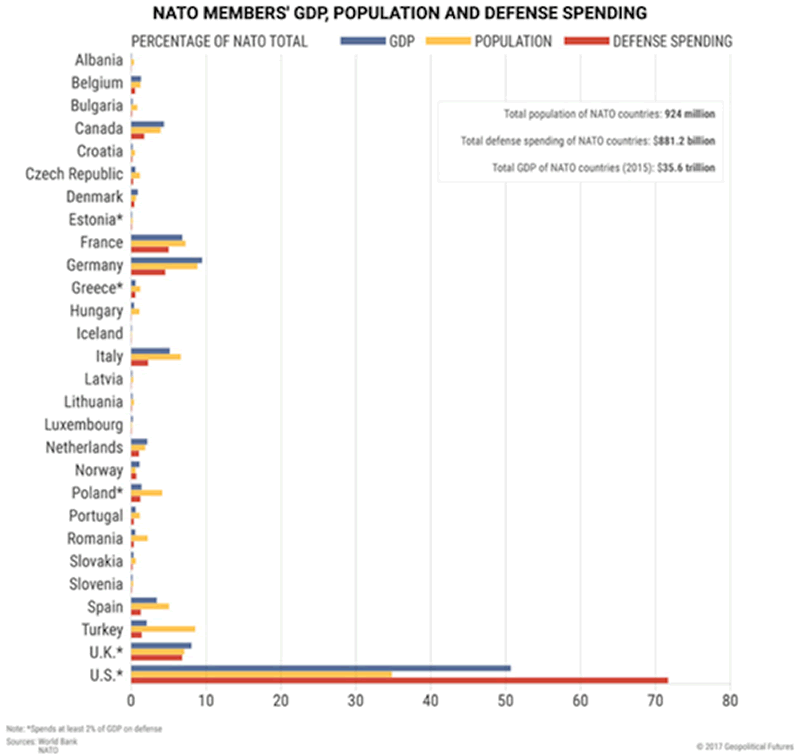Changes NATO Must Make To Remain A True Alliance
Politics / NATO Feb 28, 2017 - 10:45 AM GMTBy: John_Mauldin
 BY GEORGE FRIEDMAN AND JACOB L. SHAPIRO : US Secretary of Defense James Mattis met with defense ministers from other NATO member countries in Brussels on Feb. 15. He had a message to deliver from the Trump White House.
BY GEORGE FRIEDMAN AND JACOB L. SHAPIRO : US Secretary of Defense James Mattis met with defense ministers from other NATO member countries in Brussels on Feb. 15. He had a message to deliver from the Trump White House.
The meeting was closed, but some of Mattis’s comments were released to the media: “America will meet its responsibilities, but if your nations do not want to see America moderate its commitment to this alliance, each of your capitals needs to show its support for our common defense.” He added, “America cannot care more for your children’s security than you do.”
The previous US administration criticized NATO at times but in such a way that the complaint was not taken seriously. The new administration cannot afford for that to happen. From a US strategic view, the status quo is no longer acceptable.
Is Nato Still an Alliance?

NATO was created to be a defense alliance. Defense requires military forces. Alliance means deploying those forces to protect or support an ally. Alliances usually involve countries with varying power and capabilities. Some are weak and some are strong. This is to be expected. But sharing the burden is also expected in an alliance. Each partner gives what it can for the greater good.
By all these measures, NATO is not a coherent alliance at present. It is instead a collection of states disproportionately dependent on the US for security guarantees. This arrangement is of much less value to the US than a true alliance.
The world is more unstable today than at any point since the Soviet Union’s fall. The US is still the only global power, but it is not all-powerful. The US must have the support of allies to meet various challenges (such as China and Russia) and in its ongoing war with radical Islamism. Other NATO members also need the support of the US.
Mattis has pointed out an unpleasant truth: NATO military capabilities are not adequate to meet all of the challenges facing its members. This lack of capability can be attributed to three factors: the disproportionate level of NATO members’ defense spending, the decline in NATO members’ defense spending over the last seven years, and the unequal sharing of NATO’s burdens relative to individual members’ resources.
Issue #1: Uneven Defense Expenditures

The chart above starts at the simplest level. Not all NATO members spend a similar amount on defense. NATO estimates that alliance members’ defense expenditures totaled $918.3 billion in 2016. More than 70% of that spending came from the United States. The US spends 2.5 times more on defense than all other NATO member states combined.
For that reason, NATO is not currently a traditional military alliance. It is a list of 27 countries the US has agreed to defend.
Issue #2: Decline in Defense Spending

The data in the table above are taken directly from NATO’s own figures and show the problem from a different angle. Defense expenditures as a percentage of each individual ally’s GDP (including the US) have been decreasing steadily. Some claim this decline only began after the 2008 financial crisis. This is not true.
Only eight countries increased spending as a percent of GDP from 2005 to 2008. As the chart shows, these increases were small. In 2006, NATO states agreed at a summit in Riga that all members should spend 2% of GDP on defense. In that year, six countries met that threshold: Bulgaria, France, Greece, Turkey, the UK, and the US. In 2016, only five countries met this threshold: Estonia, Greece, Poland, the UK, and the US.
Then in 2014, some NATO countries reaffirmed their commitment to increase spending to requisite levels by 2024. But NATO member states had already agreed to those spending levels in 2006.
“Reaffirming a commitment” is code for not having fulfilled a previous promise and insisting that this time, it will be different. Promises lose their worth when they’ve been broken in the past. A decade is a long enough time to wait for an ally to live up to a promise. And 18 years is an unreasonable amount of time.
The US cannot fight wars and defend NATO’s varied interests with promises. The US cannot honor commitments unconditionally. Its power has limits. The US faces its own array of challenges in different parts of the world, and this makes having dependable allies is a crucial part of US strategy.
Issue #3: Relative Defense Spending

Not all NATO members are created equal. For example, Croatia is never going to spend an equal amount on defense as the US. But even when factoring in size, the US still spends significantly more on defense than other members.
As the chart above shows, the US accounts for about 50% of NATO members’ total GDP and 32% of their total population. But the US makes up about 72% of defense spending.
There is only one country that spends a proportionate share on defense based on its share of overall GDP and population: the United Kingdom. The US contributes far more than its share.
Every other NATO country spends less relative to its economic activity or its population. Western European countries (excluding the UK) account for 31% of NATO members’ GDP and 33% of their population. But they contribute just 16% to NATO members’ total defense spending.
Eastern European countries are much poorer and smaller than Western European countries. They account for 4.2% of NATO members’ GDP and 12.7% of their population. But Eastern Europe contributes 2.7% to defense spending. In effect, Eastern Europe contributes closer to its fair share than its far wealthier and stronger neighbors to the west.
On one hand, this makes sense. Eastern Europe faces more immediate threats than Western Europe. Eastern Europeans still have fresh memories of Soviet domination. As such, Russian aggressiveness poses a very real threat. On the other hand, it highlights that some NATO members that are able to contribute more are not pulling their weight.
The Imperative
After Mattis’s meeting with defense ministers, NATO Secretary General Jens Stoltenberg made a statement: “This is not the US telling Europe to increase defense spending. This is 28 allies, heads of states and governments sitting around the same table in 2014, and looking into each other’s eyes and agreeing that we shall increase defense spending.”
The NATO secretary general’s analysis is wrong. This is the US telling Europe to increase its defense spending. Either there will be a distinct change in NATO members’ behavior, or there will be a change in US support for NATO. If the second scenario takes shape, NATO will be replaced by a greater emphasis on important bilateral relationships.
The US has asked for help and hasn’t gotten it. Now, the US is now demanding help. NATO member states face a serious choice over whether to give the US what it wants.
I've discussed the goals of the US with regard to NATO in great depth in This Week in Geopolitics (subscribe here for free). The US wants NATO meetings to be gatherings of officials from 28 allies, each clear-eyed about the alliance’s goals, and each bearing a proportional share of that cost. For the US, that is a measure of success. It is not a description of reality.
Subscribe to George Friedman’s This Week in Geopolitics
Economic trends, social upheaval, stock market cycles, and more are all connected to powerful geopolitical currents that most of us aren’t even aware exist. Global-intelligence guru George Friedman gives you an in-depth view of these hidden forces in This Week in Geopolitics. Get it free in your inbox every Monday.
John Mauldin Archive |
© 2005-2022 http://www.MarketOracle.co.uk - The Market Oracle is a FREE Daily Financial Markets Analysis & Forecasting online publication.



